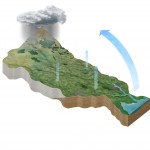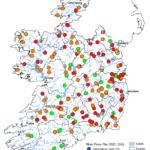Water is a precious resource, and is essential for all…
An Fóram Uisce: a framework for integrated land and landscape management
An Fóram Uisce has proposed a Framework for Integrated Land and Landscape Management (FILLM) that supports the adoption of a systems approach to landscape management that allows for the inclusion of all the relevant aspects of our natural environment in a cohesive and unified manner.
Ireland’s natural environment is an inheritance for present and future generations. Protecting and managing this inheritance is particularly demanding in the context of the climate crisis, stressed water resources, declining biodiversity and the Covid-19 pandemic. Getting the balance between our food and economic needs now and in the future, and achieving environmental sustainability, if not regeneration, is an ongoing challenge. One compelling pathway to meet this challenge is developing and utilising a systems approach that takes account of all relevant aspects of our environment in an integrated manner.
We live in and are part of an interconnected world. All the components of our natural environment – air, water, ecosystems, soils, rocks, land, landscapes – are interrelated and interlinked. Therefore, management of these components, in the context of society’s needs for nourishing food, good health and economic wellbeing, must take account of the linkages and must be undertaken in a cohesive, holistic and integrated manner. Otherwise, our natural environment will continue to decline, and our protection efforts will not be either efficient or effective.
The FILLM builds on and is a reframing of the Integrated Catchment Management (ICM) approach used in water resources management. However, it broadens it to include all components of our natural environment, atmospheric system services, geosystem services and ecosystem services while retaining catchments as the appropriate landscape units.
This whole of environment approach provides for:
- catchment-based landscape management
- multi-stakeholder engagement for strategic environmental outcomes
- the interconnection and interdependence of atmospheric system, geosystem and ecosystem services allowing for the identification of co-benefits and trade-offs
- integrated ecosystem management, with agencies working together to maximise actions
- efficient catchment-based community involvement for social and economic wellbeing, and for positive environmental outcomes.
The proposed process of FILLM Implementation requires:
- Building partnerships with local communities and other stakeholders to identify issues of concern.
- Developing a community vision for water and ecosystems.
- Characterising the catchment based on existing information, catchment walks, targeted monitoring, identification of pressure sources, evaluating hydro-morphological pressures, pollutant load reduction analysis and location of critical source areas (CSAs).
- Identification and evaluation of management strategies for protection and for improvement; locate the areas for appropriate actions within CSAs.
- Designing an implementation programme based on achieving the required environmental objectives, using the ‘right measure in the right place’ approach, economic analysis and setting milestones. Implementing the programme using metrics to track progress.
- Measuring progress to analyse trends and outcomes and making adjustments if necessary. Consulting with stakeholders at all stages.
- Identification and taking account of co-benefits for biodiversity, carbon sequestration and GHG emission reductions at all stages.
The aim is that FILLM becomes the overarching framework for environmental management as a means of connecting, for instance, the Water Framework Directive, Urban Waste Water Treatment Directive, Habitats Directive, Floods Directive, Drinking Water Directive, climate change adaption and mitigation, soil conservation, spatial planning, and sustainable food and timber production. In addition, it is a means of achieving the UN Sustainability Goals for 2030.
Ultimately, it is the implementation of measures and actions that are key to attaining the various environmental outcomes for water, air and ecosystems. Acceptance and use of the FILLM approach by policy makers, public bodies with an environmental remit and local communities encourages consideration of co-benefits, identification of synergies and can facilitate trade-offs where synergies are not feasible. Therefore, the approach helps ensure optimum results for the efforts and resources used.
Dr Gretta McCarron, An Fórum Uisce Communications and Education Lead
Learn more:
Framework for Integrated Land and Landscape Management Infographic
Framework for Integrated Land and Landscape Management Policy Document









